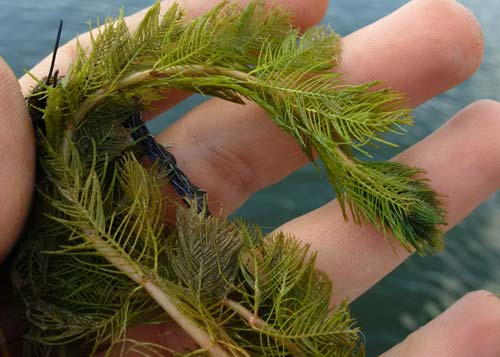Eurasian Watermilfoil
The open understory beneath Eurasian watermilfoil (Myriophyllum spicatum) is a prime place for bass seeking shelter on a sunny day. Get out your favorite creature bait and flip the holes in its canopy. Go heavy on line (braid or heavy Fluro)—you’ll need it.

Seasonal Techniques
Spring—A classic target for many anglers, Eurasian watermilfoil will be one of the first plants to sprout and grow from existing structures in the early part of spring. Find the deep water edge where this plant often grows, and work a Carolina rig or big jig around clumps of newly growing plants.
Summer—This species is often one of the first to begin topping out. Much like hydrilla, the open understory beneath is a prime place for bass seeking shelter on a sunny day. Get out your favorite creature bait and flip the holes in its canopy. Go heavy on line (braid or heavy Fluro)—you’ll need it.
Fall—Eurasian watermilfoil will begin to exhibit some browning, even in late summer. But the plants will persist well though the fall. Milfoil is the perfect opportunity for frog fishing as the canopy will easily hold up the bait, but the understory is open enough for a bass to key in on the target.
Winter—While growth may have stopped and fragmentation begun, Eurasian watermilfoil will maintain some of its leaves and stems throughout the winter months. When all other grass is gone, find those clumps of milfoil in 10+ feet of water. Fish low and slow for those fish staging before the spring spawn.
Habitat Value
Fish—Eurasian watermilfoil can provide good habitat for fry and juvenile fish species. The open understory can also provide foraging opportunities for larger predatory fish.
Waterfowl—Eurasian watermilfoil can be a key resource for waterfowl in the Tennessee Valley, not because of it’s nutritional value, but mainly because of its abundance. Eurasian watermilfoil has been associated with avian vacuolar myelinopathy (AVM) in other areas, which can negatively impact water birds and predatory birds like eagles.
Identifying Features
What It Looks Like—Eurasian watermilfoil is easily identified by its feathery leaf appearance. Leaves, in sets of four, can be found whorled around the stem of the plant. Each leaf will have up to 12 pairs of leaflets, giving the plant its featherlike appearance.
Where to Find It—Eurasian watermilfoil was once the most abundant and well-known plants in the Tennessee River system. In recent years, hydrilla has begun to dominate traditional areas of milfoil. However milfoil can still be found in abundance throughout many reservoirs in the system.
Max Depth—0 to 15 feet
Similar Species—Eurasian watermilfoil may appear similar to cambomba and coontail, however Eurasian watermilfoil has a whorled leaf orientation, unlike the opposing-leaf arrangement of cabomba.
Drawbacks
Eurasian watermilfoil was traditionally one of the most problematic weeds in the Tennessee Valley. In recent years, it has been replaced mostly by hydrilla. However milfoil does continue to cause problems in some TVA reservoirs. Cost to manage: $$$$ out of $$$$$.
Contact Us
We're always looking for more information about aquatic plants on TVA reservoirs. Let us know where and what you see, and send us your photos. Email us.